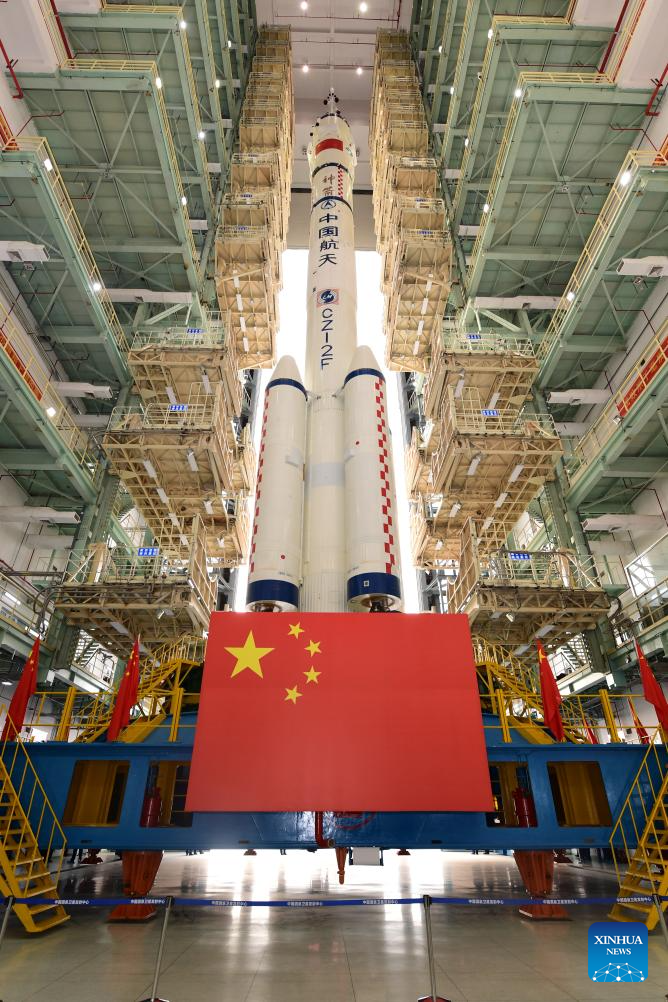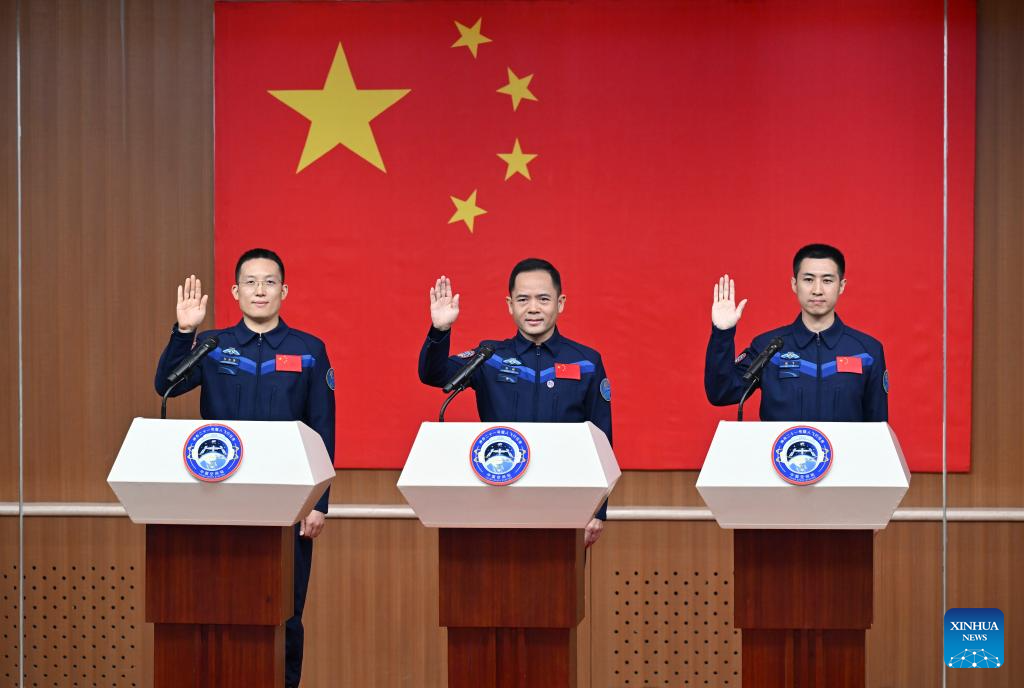25.10.2025

This photo taken on Oct. 24, 2025 shows the combination of the Shenzhou-21 crewed spaceship and a Long March-2F carrier rocket to be transferred to the launching area. The Shenzhou-21 crewed spaceship will be launched at an appropriate time in the near future, the China Manned Space Agency (CMSA) said on Friday. The combination of the spaceship and a Long March-2F carrier rocket has been transferred to the launching area, according to the CMSA. All facilities and equipment at the launch site are in good condition, while various pre-launch function checks and joint tests will be carried out as planned. (Photo by Wang Jiangbo/Xinhua)
The Shenzhou-21 crewed spaceship will be launched at an appropriate time in the near future, the China Manned Space Agency (CMSA) said on Friday.
The combination of the spaceship and a Long March-2F carrier rocket has been transferred to the launching area, according to the CMSA.
All facilities and equipment at the launch site are in good condition, while various pre-launch function checks and joint tests will be carried out as planned.
Quelle: Xinhua
----
Update: 31.10.2025
.
China unveils Shenzhou-21 crew for more diversified space sci-tech experiments
Chinese astronauts Zhang Lu, Wu Fei and Zhang Hongzhang will carry out the Shenzhou-21 crewed spaceflight mission, and Zhang Lu will be the commander, the China Manned Space Agency announced at a press conference on Thursday.
The Shenzhou-21 crewed spaceship is scheduled for launch at 11:44 p.m. Friday (Beijing Time) from the Jiuquan Satellite Launch Center in northwest China, said Zhang Jingbo, spokesperson of the agency.
The three astronauts are a space pilot, a flight engineer, and a payload specialist, respectively, representing the three types of Chinese astronauts in service, he added.
Zhang Lu was a crew member of the Shenzhou-15 mission. Wu Fei and Zhang Hongzhang, both from the third batch of Chinese astronauts, will carry out the spaceflight mission for the first time.
Before being selected as an astronaut, Wu Fei was an engineer at the China Academy of Space Technology under the China Aerospace Science and Technology Corporation, and Zhang Hongzhang was a researcher at the Dalian Institute of Chemical Physics under the Chinese Academy of Sciences.
It has been two years since Zhang Lu last went into space. He told the press on Thursday that his heart is now "filled with excitement and anticipation." He has readjusted to the high-intensity training since the end of the Shenzhou-15 mission, engaging in extensive learning and research focused on the new characteristics of the space station mission.
Zhang Lu revealed that during their six-month stay in orbit, the crew is going to celebrate the Spring Festival in a more surprising and interactive way.
"I hope to use a brand-new method to integrate traditional Chinese culture with aerospace technology," he said, hoping their festival greetings will display the romantic side of Chinese astronauts, aside from their meticulousness.
Wu Fei is the youngest among the Shenzhou-21 crew. As a spaceflight engineer, his responsibilities include looking after the space station, managing its daily affairs, and handling equipment maintenance, repair and upgrades.
"I believe in the saying 'the harder you work, the luckier you get.' Integrating my dream into the country's great space endeavor is the best luck bestowed upon me by the times," he said.
Zhang Hongzhang, a payload specialist, will be in charge of sci-tech application research tasks, involving aerospace medicine, space life science, space material science, space microgravity physics, space new technology and application, and other fields.
He will conduct experimental procedures, perform observations, acquire data, and carry out data processing and analysis.
He has long been engaged in the research on new energy and new materials. Additionally, he will be able to work on his own research project during the mission. "It is a long-cherished dream of every payload specialist to bring self-designed experiments to the space station," he said.
There will be 27 new science and application projects for the new crew to do in the space station, covering space life sciences and biotechnology, space medicine, space material science, microgravity fluid physics and combustion, and new space technologies.
The mission also planned in-orbit studies on lithium-ion batteries for space applications, and intelligent computing platforms.
The mission is the sixth manned flight mission since the space station entered the application and development phase, and the 37th flight of China's manned spaceflight program.
The Shenzhou-21 astronauts will complete in-orbit rotation with the Shenzhou-20 crew. They will also perform extravehicular activities (EVAs) and cargo handling, install space debris protection devices, deploy and recover extravehicular payloads and equipment.
They will participate in science education and public welfare activities as well.
During their stay in orbit, the Shenzhou-21 crew will welcome the Tianzhou-10 cargo spacecraft and the Shenzhou-22 crewed spaceship.
The Shenzhou-20 crew has been in orbit for 188 days and is expected to set a new record for the longest stay in orbit by a Chinese astronaut crew. During the period, the crew fulfilled a total of four EVAs and seven payload entry and exit tasks.
The Shenzhou-20 crew will return to the Dongfeng landing site in north China's Inner Mongolia Autonomous Region after completing the in-orbit handover with the Shenzhou-21 crew, the spokesperson added.
Quelle: Xinhua
+++
New extravehicular spacesuits offer astronauts greater comfort, convenience: official
Two new extravehicular spacesuits are able to provide astronauts with greater comfort and convenience during spacewalk activities, according to the China Manned Space Agency (CMSA) on Thursday.
These two new suits, delivered to orbit in July 2025 by the Tianzhou-9 cargo spacecraft, feature improvements in thermal comfort, human-machine interface capability and operational safety, while maintaining high standards of reliability, Zhang Jingbo, spokesperson for the CMSA, said on Thursday at a press conference focused on the upcoming Shenzhou-21 crewed spaceflight mission.
Notably, one in-orbit spacesuit, which was used more than 20 times, exceeding its original design of 15 uses within three years, will retire from future extravehicular missions.
Zhang said it is the first Chinese spacesuit to undergo in-orbit lifespan assessment and extended use -- validating the accuracy of health monitoring and evaluation models and methods for extravehicular spacesuits.
He added that further tests will be carried out on the suit's key materials and characteristic parameters. It is scheduled to be returned to Earth via a new-generation spacecraft at a later stage.
Quelle: Xinhua
+++
China discloses new space mission tasks, highlighting mice experiment
The Shenzhou-21 crew will bring 4 mice to the country's space station for scientific study, a highlight among a variety of new science and application projects to be carried out during their six-month stay in orbit, the China Manned Space Agency (CMSA) said on Thursday.
This will be the first time China conducts a scientific experiment involving rodent mammals in space, CMSA spokesperson Zhang Jingbo said at a press conference held one day prior to the launch of the Shenzhou-21 mission.
The mice, two males and two females, will be raised in orbit, and the study will focus on examining the effects of space conditions, such as microgravity and enclosed space, on the behavior of these animals, Zhang said.
Subsequently, the mice will return to Earth via a spaceship, and further scientific research will be carried out to explore the stress response and adaptive changes of multiple tissues and organs of mice in the space environment, Zhang added.
The four mice were chosen after more than 60 days of rigorous training in physical fitness and cognitive ability. They will be part of scientific experiments in space for five to seven days, helping to close a gap in small mammal research aboard China's Tiangong space station.
Previous animal experiments conducted on the Chinese space lab involved zebra fish and fruit flies.
The Shenzhou-21 crewed spaceship is scheduled to be launched at 11:44 p.m. Friday (Beijing Time) from the Jiuquan Satellite Launch Center in northwest China. Taikonauts Zhang Lu, Wu Fei and Zhang Hongzhang will carry out the Shenzhou-21 mission.
The 27 new in-orbit experiments awaiting the trio cover areas including space life sciences and biotechnology, space medicine, space materials science, microgravity fluid physics and combustion, and new space technologies.
The CMSA also outlined planned in-orbit studies on the relationship between the origin of genetic codes and chirality, lithium-ion batteries for space applications, and intelligent computing platforms.
Notably, crew member Zhang Hongzhang, a payload specialist, is a researcher in the field of new energy and new materials at the Dalian Institute of Chemical Physics under the Chinese Academy of Sciences.
During the Shenzhou-21 mission, his ideas from the ground are expected to bear fruit in the orbital lab, as the experiments he designed will be conducted on the space station.
He will be responsible for conducting experimental procedures, performing observations, acquiring data, and carrying out data processing and analysis.
"I feel truly honored that the experiment project I have contributed to will be conducted in space," the scientist-turned-taikonaut told media.
Quelle: Xinhua
+++
Astronauts of China's Shenzhou-21 mission meet press

Chinese astronauts Zhang Lu (C), Wu Fei (R) and Zhang Hongzhang for the upcoming Shenzhou-21 spaceflight mission, meet the press in Jiuquan Satellite Launch Center in northwest China on Oct. 30, 2025. (Xinhua/Li Minggang)
Chinese astronauts Zhang Lu, Wu Fei and Zhang Hongzhang for the upcoming Shenzhou-21 spaceflight mission, met the press on Thursday.
The Shenzhou-21 crewed spaceship is scheduled to be launched at 11:44 p.m. Friday (Beijing Time) from the Jiuquan Satellite Launch Center in northwest China, the China Manned Space Agency announced at a press conference earlier on the day.

Chinese astronauts Zhang Lu (C), Wu Fei (R) and Zhang Hongzhang for the upcoming Shenzhou-21 spaceflight mission, meet the press in Jiuquan Satellite Launch Center in northwest China on Oct. 30, 2025. (Xinhua/Li Zhipeng)
Quelle: Xinhua
